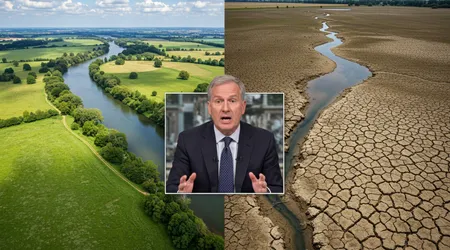England Faces Water Crisis: Minister Warns of Shortages Without New Reservoirs

England faces water crisis as dwindling reservoir levels and rising demand threaten household and business supplies by the mid-2030s.
Water Minister Emma Hardy’s stark warning underscores a looming challenge: without new reservoirs, the nation risks Mediterranean-style rationing, hosepipe bans, and disrupted economic growth.
This isn’t just about dry summers it’s a structural failure decades in the making. Population growth, climate change, and aging infrastructure have collided, leaving England’s water security hanging by a thread.
This article delves into the crisis’s roots, the government’s response, and why bold, multifaceted solutions are critical to avoid empty taps.
The issue is urgent yet complex, woven into environmental, economic, and social fabrics. Since privatization in 1989, no major reservoirs have been built, despite a population increase of over 10 million.
Climate-driven drier summers exacerbate shortages, while leaky pipes waste billions of liters annually. The government’s push to fast-track reservoirs is a start, but is it enough?
Here, we unpack the crisis, explore solutions, and ask: can England secure its water future before time runs out?
The Perfect Storm: Why England Faces Water Crisis
A confluence of factors has pushed England’s water system to the brink. Population growth, particularly in water-stressed regions like the Southeast, strains existing supplies.
The Environment Agency reported in May 2025 that reservoir levels in northwest England were 10% below average, signaling drought risks after a record-dry spring.
England faces water crisis because demand is outpacing supply, with no new reservoirs built in over 30 years.
Climate change intensifies the problem. Drier summers and erratic rainfall patterns reduce groundwater recharge, leaving reservoirs critically low.
The UK Centre for Ecology and Hydrology warns that without significant rainfall, shortages could hit by 2035. Aging infrastructure compounds this leaky pipes lose up to 20% of water daily.
++ Trends in gadgets and connected devices: what to expect from the tech market this year
Imagine a bucket with a hole: no matter how much you pour in, it’s never enough.
Privatization’s legacy looms large. Water companies, prioritizing profits, have underinvested in infrastructure while paying out billions in dividends.
Since 1989, 25 reservoirs were sold off, with no replacements. England faces water crisis not just from nature but from systemic neglect. Can we afford to ignore this any longer?

Government’s Response: Fast-Tracking Reservoirs
The government is acting to avert disaster. Water Minister Emma Hardy announced plans to designate new reservoirs as “nationally significant,” bypassing local planning delays.
Two projects in Cambridgeshire and Lincolnshire are already greenlit, with seven more planned by 2050. These could supply 670 million liters daily, supporting 750,000 homes.
England faces water crisis, and this move signals urgency, but is it a silver bullet?
Streamlining approvals is pragmatic. Local councils often stall projects due to environmental or community concerns, delaying critical infrastructure.
Also read: Record Heatwaves and Wildfires Spark Urgent Debate on Climate Policy and Preparedness
Environment Secretary Steve Reed’s intervention ensures ministers, not local bodies, decide. Yet, critics argue this risks overriding legitimate ecological worries.
For example, new reservoirs could disrupt wetlands, harming biodiversity. Balancing speed with sustainability is delicate.
Skeptics, like Shadow Environment Secretary Victoria Atkins, claim Labour’s focus masks broader failures, such as unchecked migration driving population growth.
England faces water crisis, but rushing reservoirs without addressing demand through conservation or leak repairs may fall short. The government must tread carefully to avoid trading one crisis for another.
Read more: Russian Spy Ring Leader Sentenced: What the Verdict Means for UK Security
Beyond Reservoirs: A Holistic Approach to Water Security
Reservoirs alone won’t solve the problem. Experts argue for a broader strategy, including water reuse and demand management.
Recycling wastewater, as practiced in Singapore, could reduce strain on freshwater sources. England faces water crisis, yet only 4% of UK water is reused, compared to Israel’s 90%. Why aren’t we learning from global leaders?
Reducing consumption is critical. Households use 145 liters per person daily, but simple changes like shorter showers or water-efficient appliances could cut this by 20%.
Businesses, especially agriculture, consume the lion’s share. Precision irrigation, used in arid regions like Australia, could save millions of liters.
England faces water crisis, but smarter usage could stretch supplies further.
Fixing leaks is non-negotiable. In 2023, England lost 1 trillion liters to leaks enough to fill 400,000 Olympic pools. Water companies must invest in modernizing pipes, not dividends.
Picture a sinking ship: building new reservoirs is like adding lifeboats, but plugging the holes is just as urgent.
The Economic and Social Stakes
Water shortages threaten more than dry taps they jeopardize economic stability. Water-intensive industries, like agriculture and manufacturing, face disruptions, risking jobs and food security.
In Cambridge, water scarcity already stalls housing projects, delaying 10,000 new homes. England faces water crisis, and without action, economic growth could grind to a halt.
Socially, rationing would hit vulnerable communities hardest. Low-income households, already stretched, would struggle with restrictions or rising bills.
In 2022, 3.2 million households faced water poverty, spending over 5% of income on bills. Rationing could exacerbate inequality, turning access to water into a luxury. England faces water crisis, and the human cost demands urgent attention.
Public awareness is growing. Campaigns like Scottish Water’s 2025 appeal, which cut usage by 150 million liters daily, show people can adapt.
But long-term behavior change requires education and incentives, not just warnings. The government must inspire, not just alarm, to secure public buy-in.

The Path Forward: Innovation and Collaboration
Innovation offers hope. Desalination, though energy-intensive, could tap England’s coastal abundance. Israel produces 600 million liters daily via desalination why not explore this here?
Small-scale pilots in Kent could scale up, diversifying supply. England faces water crisis, but technology could bridge the gap.
Collaboration is key. Water UK’s call for a national water grid moving water from wetter to drier regions deserves serious consideration.
Farmers, like those in Norfolk who built private reservoirs, show grassroots solutions work. Government, industry, and communities must align to share resources and knowledge.
Time is short. The National Drought Group, convened in May 2025, warns of summer shortages without sustained rainfall.
England faces water crisis, but a mix of reservoirs, conservation, and innovation can avert disaster. The question is whether we act decisively or let the taps run dry.
Data Snapshot: England’s Water Challenge
| Metric | Value | Source |
|---|---|---|
| Reservoir shortfall by 2035 | 2.4 billion liters/day | Environment Agency, 2025 |
| Annual water loss to leaks | 1 trillion liters | Ofwat, 2023 |
| New reservoirs planned by 2050 | 9, supplying 670M liters/day | DEFRA, 2025 |
| Household water use | 145 liters/person/day | Water UK, 2024 |
This table highlights the scale of the challenge and the government’s response, but it also underscores the need for broader solutions beyond new reservoirs.
Frequently Asked Questions
Q: Why is England facing a water crisis now?
A: England faces water crisis due to population growth, climate-driven dry spells, aging infrastructure, and no new reservoirs since 1989. Leaks and underinvestment worsen the issue.
Q: How can individuals help prevent water shortages?
A: Simple actions like fixing leaky taps, using water-efficient appliances, and cutting shower time can reduce household use by up to 20%.
Q: Are new reservoirs the only solution?
A: No. Conservation, leak repairs, water reuse, and technologies like desalination are critical. Reservoirs are part of a broader strategy to secure supplies.
Sources
- Environment Agency, May 2025: Drought status report for northwest England.
- Ofwat, 2023: Annual water loss statistics.
- DEFRA, May 2025: Reservoir planning announcements.
- Water UK, 2024: Household water consumption data.
This article blends urgency with actionable insights, weaving a narrative that’s both alarming and hopeful. England faces water crisis, but with bold action, we can turn the tide.
